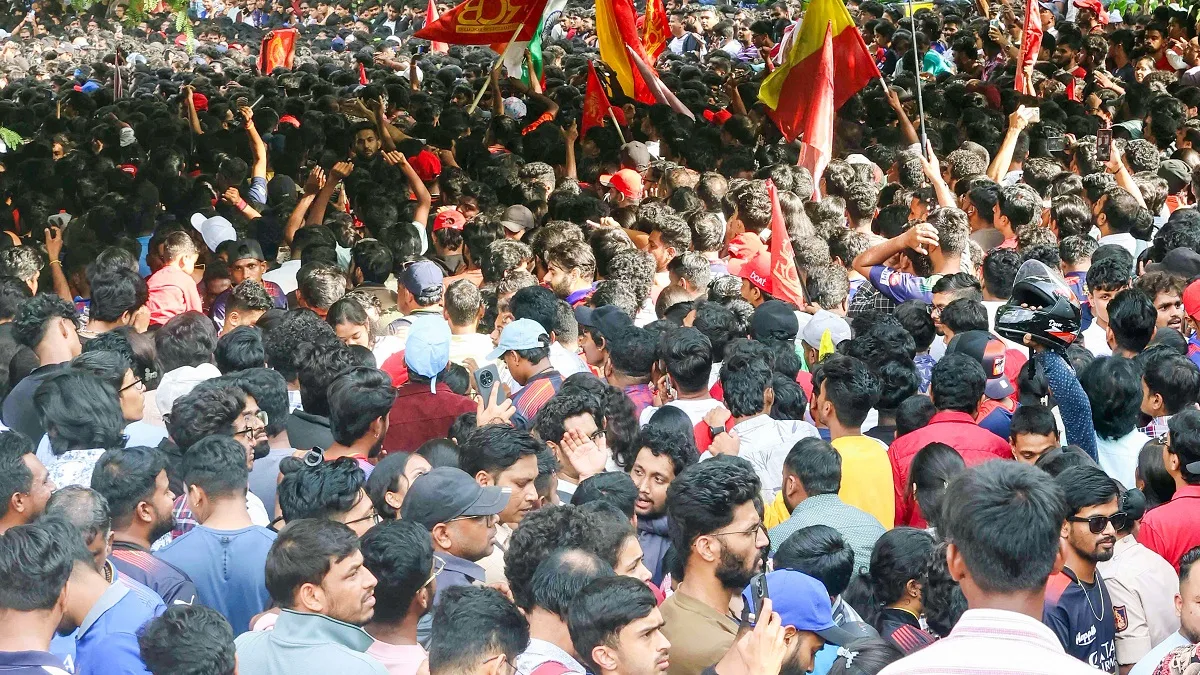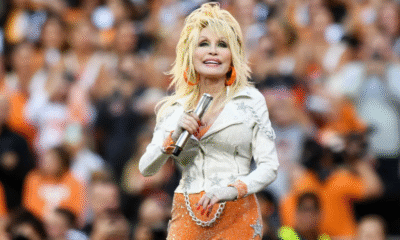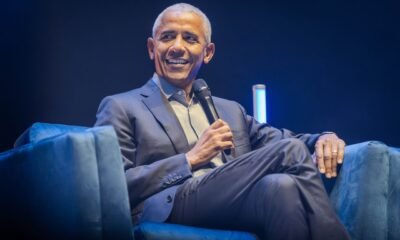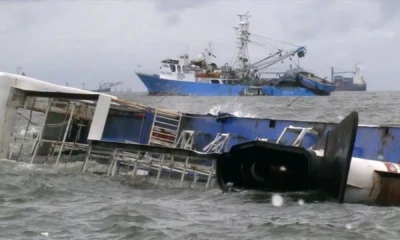India
India Unveils the World’s Highest Rail Bridge Built as Part of a $5.5 Billion Mega Project and It’s an Engineering Marvel You Must See
Indian Prime Minister Narendra Modi inaugurates the breathtaking Chenab Bridge and Vande Bharat trains in Jammu and Kashmir, reshaping connectivity and national pride.

In what is being hailed as a monumental moment for Indian infrastructure, the Indian Prime Minister inaugurated the world’s highest railway bridge, the Chenab Bridge, during a landmark visit to Jammu and Kashmir. Standing taller than the Eiffel Tower and part of a massive ₹46,000 crore (approx. $5.5 billion USD) infrastructure push, this achievement isn’t just a symbol of engineering brilliance—it’s a transformative leap in connecting the Kashmir Valley to the rest of India.
The Chenab Bridge, rising 359 meters (1,177 feet) above the riverbed and stretching over 1.3 kilometers, is now officially the tallest railway bridge in the world. Built at a cost of ₹1,486 crore, it took over two decades of precise planning, international collaboration, and sheer grit to complete. Its height exceeds the Eiffel Tower by 35 meters and it’s designed to withstand wind speeds of up to 266 km/h, major earthquakes, and extreme Himalayan weather conditions.
During the inauguration, Indian PM Narendra Modi called the project a dream come true and emphasized its strategic and economic importance: “Now, Kashmir’s apples will reach bigger markets at lower costs and on time.” He also flagged off two Vande Bharat Express trains connecting Katra to Srinagar, reducing travel time significantly and promising smooth connectivity even during the harshest winters.
This project is part of the 272-km-long Udhampur-Srinagar-Baramulla Rail Link (USBRL), a game-changer for the region that includes 36 tunnels, 943 bridges, and India’s first cable-stayed railway bridge at Anji Khad. The rail line now offers all-weather, seamless connectivity through mountainous terrain, allowing not only faster transportation of goods like Pashmina shawls and Kashmiri apples but also boosting tourism and pilgrim travel.
Modi’s visit to the region was his first since Operation Sindoor, a military response to a recent terror attack. It underlined the Indian government’s commitment to long-term peace and development in a historically conflict-prone region. The Prime Minister also took time to meet engineers and workers who had dedicated years of effort to the project’s success, praising their dedication in making what he called “one of India’s greatest civil-engineering achievements.”
Jammu and Kashmir Chief Minister Omar Abdullah also praised the efforts, stating that even the British during colonial rule couldn’t bring rail to Kashmir, but today, thanks to this effort, the region has entered a new era of modern connectivity. “What once felt like a distant dream has now become a living reality,” he said.
The new Vande Bharat Express trains are also packed with state-of-the-art features like silicon heating pads, bio-toilets, anti-spall protection, and an auto-draining mechanism that ensures uninterrupted service even in sub-zero temperatures. With this development, India not only strengthens its transport network but also showcases its growing capability to take on complex infrastructure challenges on a global scale.
World
Three Indian Breakfasts Just Ranked Among the World’s Top 50 and the Internet is Drooling
Taste Atlas crowns Misal Pav, Paratha, and Chole Bhature as global breakfast icons in its 2025 rankings

In a delicious moment of global recognition, three beloved Indian breakfast dishes have found their rightful place on the international culinary map. According to Taste Atlas’ newly released Top 50 Best Breakfasts in the World list for June 2025, Misal Pav, Paratha, and Chole Bhature have emerged as standout staples — proving yet again that India doesn’t just wake up, it wakes up hungry and flavorful.
Ranked at an impressive No. 18, Misal Pav from Maharashtra stole hearts with its vibrant palette and fiery punch. Known for its crunchy base, spicy gravy, and riot of toppings, this local hero isn’t just food — it’s an experience. As Taste Atlas poetically described it, a true misal is “mandatory to be spicy,” and must look like “a work of art” splashed in shades of red, brown, orange, and green. It’s a dish that defines both breakfast and boldness.
Coming in at No. 23, Paratha — the North Indian flatbread that rules breakfast tables — is more than just a category. Stuffed or plain, drenched in butter or paired with curd, this humble yet hearty delight has countless regional variations, from Punjab to Bihar. Whether it’s the aloo paratha of dhabas or the paneer-stuffed version served at posh brunch spots, its versatility and soul-satisfying flavor have earned it global fans.
And at No. 32, Delhi’s street food royalty Chole Bhature got its well-deserved spotlight. This indulgent pairing of fluffy, deep-fried bread with spicy chickpea curry is not just a breakfast—it’s a feast. While it originated in North India, Chole Bhature has transcended state borders and can now be found sizzling in every corner of the country.
What’s even more exciting is that this isn’t India’s first global food triumph. Earlier, Indian classics like Shrikhand, Palak Paneer, and Nihari also found mention in the extended list of Taste Atlas’ rankings, which features dishes beyond the top 50. It’s clear that the world is waking up to the irresistible flavors of Indian cuisine—one bite at a time.
From the streets of Delhi to the kitchens of Maharashtra, these dishes reflect the deep connection between food, culture, and community. They’re more than breakfast — they’re edible heritage. And thanks to platforms like Taste Atlas, the world is finally giving Indian breakfasts the recognition they’ve long deserved.
India
How Social Media is Fueling Hindu-Muslim Clashes in India.
From viral misinformation to algorithm-driven outrage, digital platforms are accelerating communal tensions across India.

From viral misinformation to algorithm-driven outrage, digital platforms are accelerating communal tensions across the country.

In recent years, India has witnessed a disturbing rise in communal violence, with social media platforms often serving as the catalyst. Incidents like the 2023 Satara riots and the 2020 Bangalore unrest underscore how a single provocative post can ignite widespread conflict. These platforms, designed to connect people, are increasingly being exploited to deepen divisions between Hindu and Muslim communities.
The algorithms that govern content visibility on platforms like Facebook and X (formerly Twitter) are designed to maximize user engagement. Unfortunately, this often means that sensational and polarizing content is prioritized, creating echo chambers that reinforce existing biases. Studies have shown that such environments can accelerate radicalization, as users are continually exposed to one-sided narratives that vilify the ‘other’.
Law enforcement agencies are increasingly recognizing the threat posed by digital misinformation. In Mangaluru, for instance, six individuals were arrested for sharing inflammatory content aimed at disrupting communal harmony. Similarly, the Uttar Pradesh Police have implemented real-time social media monitoring to preempt potential flashpoints during sensitive periods like religious festivals. These measures, while necessary, highlight the reactive nature of current strategies in addressing digital provocations
The psychological impact of online hate speech is profound. Continuous exposure to derogatory content can desensitize individuals, making extremist views seem acceptable. This normalization of hate not only erodes societal cohesion but also emboldens individuals to act on their prejudices, leading to real-world violence. The tragic death of a techie in Pune, following the circulation of morphed images on Facebook, serves as a grim reminder of the tangible consequences of digital hate.
Addressing this multifaceted issue requires a concerted effort from all stakeholders. Social media companies must enhance their content moderation policies, especially in regional languages, to effectively curb the spread of hate speech. Educational initiatives aimed at promoting digital literacy can empower users to critically assess the content they consume and share. Moreover, political leaders and influencers bear the responsibility of fostering narratives that promote unity rather than division.
World
RCB Victory Turns Into Nightmare as Stampede Outside Stadium Claims 11 Lives
What should have been a historic celebration for Royal Challengers Bengaluru ended in heartbreak as massive crowd mismanagement led to a deadly tragedy

A day meant for celebration turned into a scene of unimaginable sorrow in Bengaluru as at least 11 people lost their lives and over 30 were injured during a stampede outside the M Chinnaswamy Stadium on June 4. Fans had gathered in the lakhs to witness Royal Challengers Bengaluru‘s (RCB) first-ever IPL victory parade—a moment 18 years in the making—but chaos ensued as crowd control failed dramatically.
According to Karnataka Chief Minister Siddaramaiah, more than 2-3 lakh people flooded the streets around the stadium, far exceeding crowd management estimates. The situation spiraled out of control as fans pushed against closed gates and barriers, trying to catch a glimpse of their cricketing heroes. “No one expected this much crowd,” the Chief Minister stated, confirming the tragic toll from the incident.
The stampede occurred near gates 3, 10, and 21 of the stadium, with emergency exits and nearby metro stations, including Cubbon Park and MG Road, being shut down temporarily. The injured were rushed to Bowring Hospital and Vaidehi Hospital, where officials confirmed seven deaths at Bowring and four at Vaidehi.
As news of the tragedy broke, RCB released a heartfelt statement, expressing deep sorrow and offering condolences to the bereaved families. The team cut their celebration short “out of respect” and coordinated closely with local authorities. “RCB mourns the tragic loss of lives,” the statement read.
National leaders and cricketing legends echoed the nation’s grief. Prime Minister Narendra Modi called the tragedy “heartrending” and offered prayers for the injured. President Droupadi Murmu and Vice President Jagdeep Dhankhar also extended their condolences. Former cricket icons like Sachin Tendulkar and Harbhajan Singh expressed heartbreak over the incident, noting how a joyous occasion quickly turned “beyond tragic.”
However, political blame games have intensified. Union Minister H.D. Kumaraswamy accused the Congress-led Karnataka government of ignoring police warnings and failing to anticipate the crowd surge. Union Minister Prahlad Joshi alleged that the police were pressured into approving the felicitation ceremony, calling the tragedy a result of “poor planning.” BJP leaders demanded judicial investigations, while the Congress defended its response, saying it was caught off-guard by the unexpected turnout.
In a gesture of support, the Karnataka government announced ₹10 lakh in compensation for each of the victims’ families. Deputy CM D.K. Shivakumar issued a public apology, admitting the crowd was “uncontrollable” and stated that law enforcement chose not to use force on the “young and vibrant crowd.”
What should have been RCB’s brightest moment now carries a shadow of grief, raising serious questions about event planning, civic preparedness, and crowd safety at public gatherings. As the city mourns, the tragedy serves as a stark reminder of how unchecked excitement can quickly become deadly in the absence of foresight and coordination.
-

 Entertainment1 week ago
Entertainment1 week agoDolly Parton delays Las Vegas concerts by nine months citing health challenges but promises unforgettable return
-

 Entertainment1 week ago
Entertainment1 week agoZoey Deutch engaged to comedian Jimmy Tatro after 4 years of dating with romantic beach proposal
-

 Politics1 week ago
Politics1 week agoBarack Obama blasts Trump over Tylenol autism claim calling it ‘violence against truth’ but that’s not all he said…
-

 Entertainment5 days ago
Entertainment5 days agoSurvivor Season 49 episode 2 shocker Kele tribe loses again and fans stunned by who went home
-

 Sports4 days ago
Sports4 days ago‘Silent killer’ Cam Schlittler stuns Red Sox as Yankees rookie makes history with 12 strikeouts
-

 Crime & Justice6 days ago
Crime & Justice6 days agoProsecutors demand 11 years for Diddy after shocking trial says Cassie’s testimony revealed dark truth
-

 Sports5 days ago
Sports5 days agoTottenham’s Champions League wake-up call… why Spurs must stop looking like a Europa League side
-

 Sports3 days ago
Sports3 days agoShohei Ohtani finally pitches in MLB playoffs after 2,746 days… will this be the moment that defines Dodgers vs Phillies?





























MoviezHive
June 6, 2025 at 10:39 AM
Hey there!
Welcome to Moviezhive.com, where blockbuster entertainment is just a click away!
Stream a vast collection of Bollywood, Hollywood, and international movies for free—no subscriptions, no hassles.
What Makes Us Special?
✔️ Thousands of movies across all genres
✔️ Zero pop-up ads for seamless viewing
✔️ Advanced zero-buffering tech for smooth playback
✔️ Fresh titles added regularly
Can’t find a movie? Request it, and we’ll upload it fast!
Watch anytime, anywhere. Visit https://moviezhive.com now and start your movie adventure!
Enjoy the Show,
The Moviezhive Team